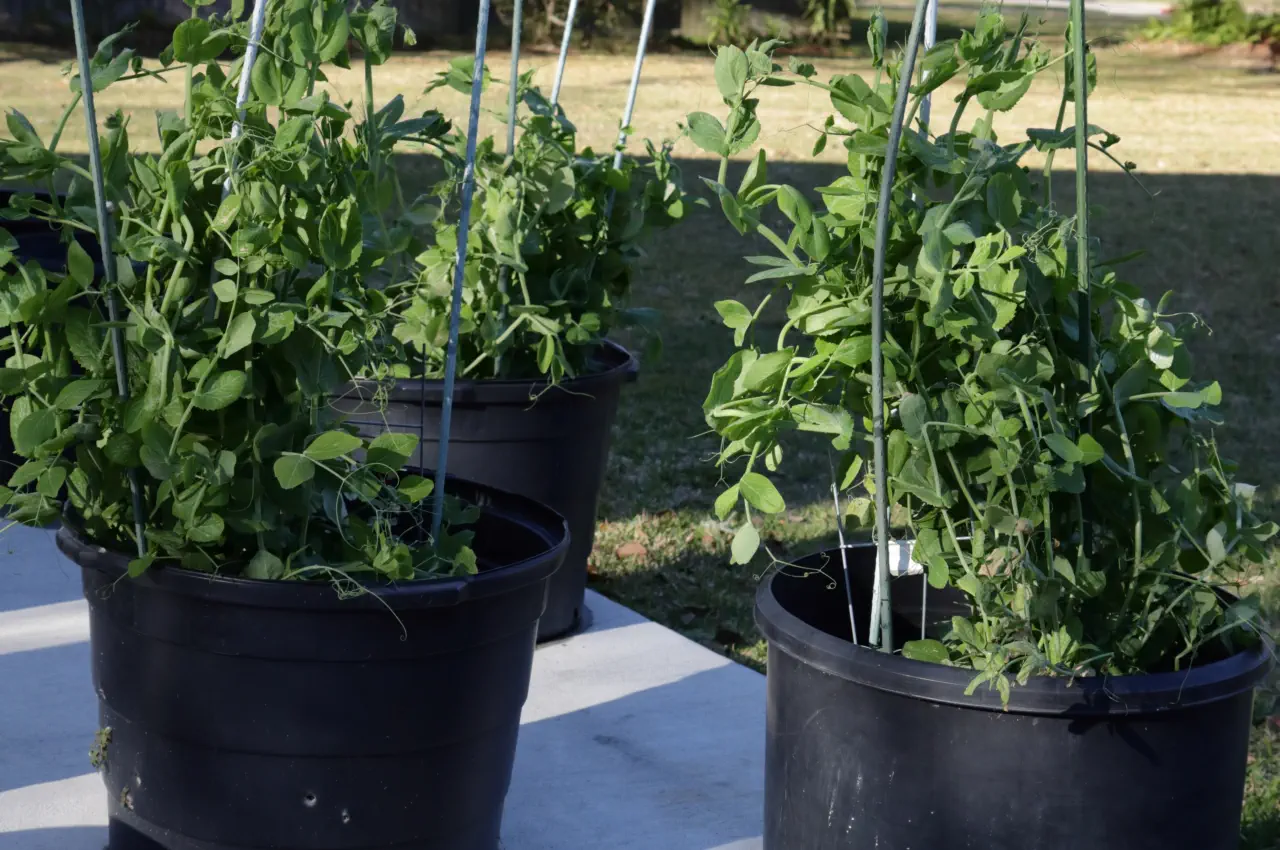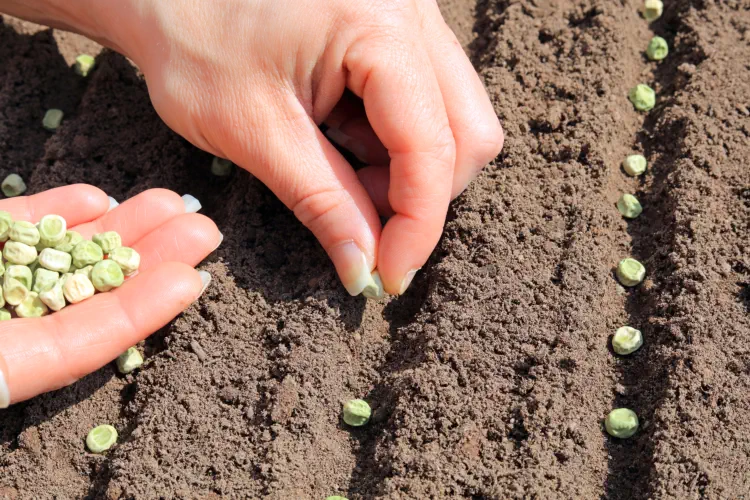Blight can wipe out your crop. Choosing the right blight resistant seed potatoes is crucial for a healthy harvest.
Read on to find out the top varieties of blight resistant seed potatoes that will save your yield....

If you’re aiming to grow your peas in pots and other containers, you’ve come to the right place. We’ll give you with the practical know-how you need, from selecting the right pot to harvesting your crop. Discover the essential steps to nurture growing peas from seeds at home.
Your container’s dimensions and material can significantly impact the health and yield of your pea plants. Here are the specifics you should consider:
The depth of the container plays a pivotal role in determining its suitability. Your pea plant’s roots need ample space to grow and absorb nutrients. An 8 to 18-inch deep container is ideal for this purpose. This ensures your pea plants have sufficient room to flourish, leading to a healthier crop.
The choice of pot material holds as much significance as its size. Unglazed ceramic or terracotta pots provide breathability, and these porous materials help prevent overwatering, a common downfall in container gardening.
However during hotter summers, the benefits of plastic in keeping water within the container, is obviously beneficial, and will mean less watering. If using a plastic container ensure it has drainage holes.
After deciding on the suitable pot, the next step is to fill your pots. This involves creating a well-drained, nutrient-rich soil mixture.
Peas thrive in a neutral to slightly alkaline soil, with an ideal pH range of 6 to 7.5 for optimal growth. If your soil falls outside this range, fret not. A bit of lime can correct overly acidic soil.
Remember to enrich your potting soil with organic compost for a nutrient-rich environment.
Planting your pea seeds in a soil rich in nutrients is vital. Here are some tips to follow:
Amend your soil with well-rotted manure or garden compost.
Use high-potash fertiliser at planting.
Steer clear of high nitrogen fertilisers as they can disrupt pea growth and lead to large, empty pods.
Following these tips, and you'll ensure healthy pea plants and successfully grow peas.

When to Plant
Timing is everything when it comes to planting peas. For an early harvest, start your seeds indoors in February or March, during the early spring. Once they reach about 10 centimeters in height, its time to start hardening off to move outdoors.
Remember, peas thrive best in full sunlight and require moist soil to grow optimally.
Planting pea seeds is a easy process. Here’s how to do it:
Press the seeds onto the surface of the soil.
Cover them with 3 cm of soil for proper germination.
Space them at least 5 cm apart to allow for healthy growth and adequate air circulation.
For quicker germination, you can soak the seeds overnight before planting.

As climbers, pea plants require some support to attain their maximum growth. This involves providing them with structures, such as pea sticks, they can climb.
Choosing Support Structures
There are various support structures you can use for your pea plants. A teepee structure made with four canes tied together in a large pot can effectively support both peas and beans. Alternatively, pyramid-shaped canes tied at the top can provide robust support.
It’s important to install supports at an early stage to avoid root disturbance and potential damage. Carefully press supports into the soil at the pot’s edge to avoid the central area where roots develop. Remember to regularly inspect the supports for stability and adjust if necessary.
Proper watering is key to the growth of your peas. Too much water can lead to root rot, while too little can stunt growth.
Selecting an appropriate pea variety is integral to successful container gardening. Some pea varieties are better suited for pot growth than others. There are different types of peas, which we’ll now discuss below...
Sugar snap peas like ‘Lusaka’ are well-suited for container gardening. These sugar snap peas are sweet and fleshy with tender flavour. They offer ease of maintenance, making them a popular choice among home gardeners.
Lusaka is a very sweet high yielding sugar snap variety.....
Average Contents : 40g seeds
This variety boasts a quick maturity period.....
Average Contents : 40g seeds
Purple Magnolia is a unique Sugar Snap variety.....
Average Contents : 40g seeds
Snow peas are another great option for container gardening. Varieties like the 'Sweet Horizon' are recognized for their suitability in pots. They grow best in a sunny position with well-drained, but rich soil.
A high quality, heavy yielding snow pea type.....
Average Contents : 40g seeds
Something different! Shiraz is a purple mange tout type.....
Av. Packet Contents : 40g seeds
Compact shelling peas like ‘Early Onward’ and ‘Sabrina’ and 'Johan' are perfect for pots. These dwarf varieties offer an advantage due to their small size and lower growing height. They also provide a delicious reward, with sweet, plump peas that are perfect for being eaten raw or cooking.
Can be sown November, or early Spring for early cropping.....
Average Contents: 40g Seeds
A high yielding reliable maincrop variety.....
Average Packet Contents: 40g SeedsPea Kelvedon Wonder is a heavy cropping second early.....
Average Contents : 40g seeds
Like any garden, container-grown peas, including garden peas, can fall prey to pests and diseases. Understanding how to identify and manage these threats is critical to maintaining plant health.
We’ll discuss prevalent pests and methods to prevent diseases.
Common pests that attack peas include:
beetles
pigeons
moths
cutworms
aphids
There are several effective methods to manage these pests. For example, aphids can be removed with a strong stream of water or by carefully handpicking them off plants.
Organic sprays, including those made from soap-and-water mixtures and neem oil, can also help control aphid infestations.
Disease prevention carries as much importance as pest management. Powdery mildew is a common disease that stunts growth and shrivels leaves. Growing a resistant variety sucj and 'Sabrina' or ;Johan' can help prevent this disease.
Also, try and always use clean, preferably rain water for watering to prevent the spread of rots and wilts.
After the dedicated care and attention, it’s time to relish the yield. Harvesting at the right time ensures you get the most delicious and nutritious peas. Here are some tips for effective harvesting.
Harvesting peas is a delicate process. Here are some tips to follow:
Peas are ready to harvest when pods are visibly swollen and look full.
They should be picked every two to three days in the morning for peak freshness and crispiness.
Remember to support the stem with one hand while pinching or gently pulling pods with the other to avoid damaging the plant.
For prolonged enjoyment of your peas, appropriate storage is necessary. Storing peas in a perforated plastic bag in the refrigerator’s vegetable crisper section helps maintain their freshness. For longer storage, peas can be frozen by blanching them in boiling water, cooling them promptly in an ice bath, and then freezing them on a cookie sheet before placing them in an airtight container.
Growing peas in containers offers a rewarding gardening experience with the bonus of fresh, homegrown produce. From choosing the right pot to sowing seeds, supporting growth, managing pests, and harvesting, each step contributes to a successful pea crop. With patience and care, you can enjoy a bountiful harvest of peas from your container garden.
Yes, peas will benefit from some type of support as they grow. Bush peas, which are 2 to 3 feet tall, will need something to climb on, while climbing peas, which may reach 6 to 8 feet tall, require a sturdy trellis.
Yes, you can grow peas in buckets by providing support for the growing plants with bamboo poles, stakes, or a trellis. Try placing the bucket in a lightly shaded area until the seeds have germinated. Remember to drill some drainage holes.
The best month to plant peas is between March and early July, ensuring a sunny, well-drained spot for optimal growth and a bountiful harvest.
Pea plants require a soil depth of at least 25cm for containers. You can use a shallow, wide planter box with good drainage. This will allow you to plant peas about 5 cm deep and at least 5 cm apart. And you should be able to grow a second pea crop in late summer for a fall harvest.
The ideal soil pH for growing peas is between 6 to 7.5, which is slightly alkaline to neutral. Aim to maintain this pH range for optimal growth of your pea plants.
All blog content on this page is copyright of SimplySeed and is not to be reproduced without prior written permission. ©